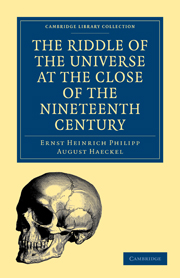Book contents
- Frontmatter
- Contents
- PREFACE
- AUTHOR'S PREFACE
- CHAPTER I THE NATURE OF THE PROBLEM
- CHAPTER II OUR BODILY FRAME
- CHAPTER III OUR LIFE
- CHAPTER IV OUR EMBRYONIC DEVELOPMENT
- CHAPTER V THE HISTORY OF OUR SPECIES
- CHAPTER VI THE NATURE OF THE SOUL
- CHAPTER VII PSYCHIC GRADATIONS
- CHAPTER VIII THE EMBRYOLOGY OF THE SOUL
- CHAPTER IX THE PHYLOGENY OF THE SOUL
- CHAPTER X CONSCIOUSNESS
- CHAPTER XI THE IMMORTALITY OF THE SOUL
- CHAPTER XII THE LAW OF SUBSTANCE
- CHAPTER XIII THE EVOLUTION OF THE WORLD
- CHAPTER XIV THE UNITY OF NATURE
- CHAPTER XV GOD AND THE WORLD
- CHAPTER XVI KNOWLEDGE AND BELIEF
- CHAPTER XVII SCIENCE AND CHRISTIANITY
- CHAPTER XVIII OUR MONISTIC RELIGION
- CHAPTER XIX OUR MONISTIC ETHICS
- CHAPTER XX SOLUTION OF THE WORLD-PROBLEMS
- INDEX
CHAPTER V - THE HISTORY OF OUR SPECIES
Published online by Cambridge University Press: 05 August 2011
- Frontmatter
- Contents
- PREFACE
- AUTHOR'S PREFACE
- CHAPTER I THE NATURE OF THE PROBLEM
- CHAPTER II OUR BODILY FRAME
- CHAPTER III OUR LIFE
- CHAPTER IV OUR EMBRYONIC DEVELOPMENT
- CHAPTER V THE HISTORY OF OUR SPECIES
- CHAPTER VI THE NATURE OF THE SOUL
- CHAPTER VII PSYCHIC GRADATIONS
- CHAPTER VIII THE EMBRYOLOGY OF THE SOUL
- CHAPTER IX THE PHYLOGENY OF THE SOUL
- CHAPTER X CONSCIOUSNESS
- CHAPTER XI THE IMMORTALITY OF THE SOUL
- CHAPTER XII THE LAW OF SUBSTANCE
- CHAPTER XIII THE EVOLUTION OF THE WORLD
- CHAPTER XIV THE UNITY OF NATURE
- CHAPTER XV GOD AND THE WORLD
- CHAPTER XVI KNOWLEDGE AND BELIEF
- CHAPTER XVII SCIENCE AND CHRISTIANITY
- CHAPTER XVIII OUR MONISTIC RELIGION
- CHAPTER XIX OUR MONISTIC ETHICS
- CHAPTER XX SOLUTION OF THE WORLD-PROBLEMS
- INDEX
Summary
Origin of man. Mythical history of creation. Moses and Linné. The creation of permanent species. The catastrophic theory: Cuvier. Transformism: Goethe. Theory of descent: Lamarck. Theory of selection: Darwin. Evolution (phylogeny). Ancestral trees. General morphology. Natural history of creation. Systematic phylogeny. Fundamental law of biogeny. Anthropogeny. Descent of man from the ape. Pithecoid theory. The fossil pithecanthropus of Dubois.
The youngest of the great branches of the living tree of biology is the science we call biological evolution or phylogeny. It came into existence much later, and under much more difficult circumstances, than its natural sister, embryonic evolution or ontogeny. The object of the latter was to attain a knowledge of the mysterious processes by which the individual organism, plant or animal, developed from the egg. Phylogeny has to answer the much more obscure and difficult question: “What is the origin of the different organic species of plants and animals?”
Ontogeny (embryology and metamorphism) could follow the empirical method of direct observation in the solution of its not remote problem; it needed but to follow, day by day and hour by hour, the visible changes which the fœtus experiences during a brief period in the course of its development from the ovum. Much more difficult was the remote problem of phylogeny; for the slow processes of gradual construction, which effect the rise of new species of animals and plants, go on imperceptibly during thousands and even millions of years.
- Type
- Chapter
- Information
- Publisher: Cambridge University PressPrint publication year: 2009First published in: 1900

